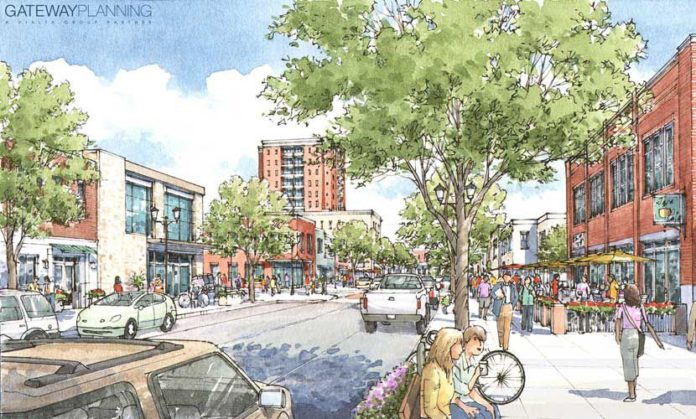Trinity Lakes
Generally bounded by the Trinity Railway Express (TRE) rail line to the north, the Trinity River to the south, Bell Spur Road to the east and Loop 820 to the west.
For more information:
fortworthtexas.gov/EcoDev/tif/14/
When the long-awaited debut of the new TEXRail commuter line becomes a reality, Fort Worth and Tarrant County will have more rail transit options than in the lifetime of most residents.
The new rail line that will connect downtown Fort Worth to Dallas Fort Worth International Airport will complement the Trinity Railway Express, the pioneer commuter rail service linking Dallas and Fort Worth.
The stalwart rail line, which first pulled out of Dallas’ Union Station on Dec. 30, 1996, was the first commuter rail line in the southwestern United States in years. Since service was extended westward into Tarrant County in 2000, it has provided the only commuter rail service available to the western side of the DFW area.
With the launch of TEXRail in about two months, local leaders say Trinity Railway Express will continue to be a vibrant part of the DFW region’s transit network and will see some significant changes within the next few years, including Sunday service.
“With TEXRail, we will truly have a regional transit system between that line, the TRE and (Dallas Area Rapid Transit’s) light-rail network,” said Bob Baulsir, senior vice president for Trinity Metro, the Fort Worth area transit agency formerly known as The T.
While the train lines will overlap in downtown Fort Worth, the two commuter lines run in different directions, forming an arc across a large swath of Tarrant County.
There have been few changes to TRE operations in the Tarrant County area since the Intermodal Transit Center and the T&P station opened on Dec. 3, 2001, completing the 34-mile route that connects downtown Dallas with downtown Fort Worth.
Since 2002, ridership has exceeded 2 million people per year with peak ridership of 2.7 million in 2008 and 2009. Ridership has remained stable at about 2.1 million people for the past several years.
Co-owned by DART and Trinity Metro, the TRE’s greatest importance – and especially for Tarrant County residents – is during the three-week run of the State Fair of Texas.
“It really doesn’t get any better than that,” Baulsir said. “Who wants to fight traffic and worry about parking, when you can sit back and relax on the train.”
Getting to Fair Park from Fort Worth involves a transfer at Victory station in Dallas to DART’s Green Line, which stops at the park’s entry gate.
For Fort Worth riders, the TRE is a popular choice for people attending Dallas Mavericks or Dallas Stars games as well as concerts and other popular events at the American Airlines Center, Baulsir said. The TRE’s Victory station is adjacent to the AAC.
The TRE station at CentrePort has made it possible for Tarrant County residents to use the train to get to DFW Airport via a shuttle bus from the station to the terminals. But the TEXRail line will be a quicker and more convenient option with a station inside the airport, officials said.
One of the biggest changes ahead in Tarrant County is a new TRE station that will anchor a major transit-oriented development.
While there is transit-oriented development tied to Victory and downtown Irving stations in Dallas County, there has been little new economic development connected to Fort Worth-area stations.
But that will change with a TRE station under construction at the sprawling Trinity Lakes development in East Fort Worth. The Trinity Metro Board of Directors agreed earlier this year to close the Richland Hills station and build a new station in the 1,600-acre development.
Richland Hills, an original city partner in The T, dropped out of the system, officials said. As a result, all the stations along the Tarrant County portion of the TRE route are within the Fort Worth city limits, including the CentrePort and Bell stations.
Newell Companies, developer of the Trinity Lakes development, has 200 acres set aside for a mixed-use development adjacent to the rail station. This development will include offices, shops, restaurants, a hotel and a variety of multi-family and attached single-family homes.
“This will be a very modern, walkable, urban type development,” said Ken Newell, president of Newell Companies. “We are very, very happy to have this train station here.”
Newell, a native of East Fort Worth, said he never imagined a station on the site when he bought the property north of the Trinity River and west of Precinct Line Road in 1999. More than 1,400 of 3,000 homes planned for Trinity Lakes have already been built, including many by Newell’s homebuilding venture.
But, Newell, whose other developments in the area include the 12,000-acre RiverBend Industrial Park, said a Fort Worth city planner told him Trinity Lakes would be the great spot for a rail station at the time the development was just getting started.
Besides being walkable for residents of the Trinity Lakes and other commuters, outdoor enthusiasts will have easy access to Trinity Trails from the station, Newell said. The popular hike-and-bike trail winds along the Trinity River through Fort Worth and is being extended east through Arlington and into Dallas.
Newell, a former board member of Trinity Metro, said he resigned to avoid a conflict-of-interest with the decision to locate the station in his development.
Because of the massive infrastructure improvements needed for the Trinity Lakes project, including several lakes, the city of Fort Worth established a TIF district in 2012 to capture tax revenue from new development to pay for the public improvements.
Newell said Trinity Lakes is similar in many ways to the Viridian development near the Trinity River in the Arlington area.
“That development is a very big deal and we feel it is a good location for a train station to serve the eastern part of the city,” Balsuir said.






